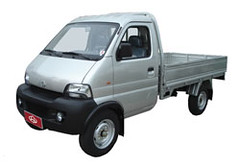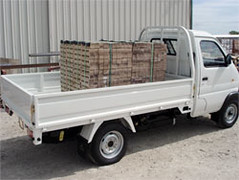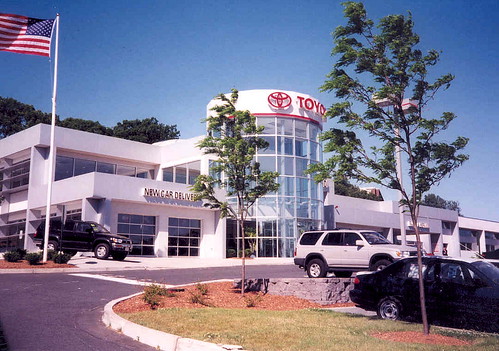Truck Buying Tips – Taking Advantage of an Economic Slowdown
In light of recent economic events, there’s a good chance that most of the people reading this post are probably waiting to buy a new truck. However, if your financial position is good, there has likely never been a better time to buy a new truck.
Tough economic times make for deep discounts on new trucks and sometimes desperate dealerships. Here’ are some tips you can use to take advantage.
Here’s a short list of suggestions for making sure you get the best price possible on your next new truck: Read more…
Auto News From Around The Web October 27, 2008
French labor board inspectors have recommended that Renault be investigated for “moral and institutional harassment of workers” following the suicides of 5 Renault product development engineers over the course of 18 months. Once of the engineers left a suicide note stating “Tell Mr. Ghosn [former head of Renault, now head of Nissan] I can’t handle the pressure anymore.” Evidently Carlos Ghosn has a reputation as a harsh taskmaster – hopefully this news will lead to changes.
Indian automaker Mahindra & Mahindra has announced that their new product line (originally scheduled to debut in early 2009) will be delayed approximately 6 months. While Mahindra and Mahindra has promised to offer inexpensive trucks and SUVs with compact diesels that get 30mpg+, a recent product review by JD Power identified nearly 200 ‘issues’ with the vehicles…everything from a lack of cupholders to inferior quality interior components. Of course a few growing pains are to be expected for any foreign automaker entering the U.S. market, but it’s going to be interesting to see if the new Mahindra vehicles will be ready for prime-time when they debut late next year.
Following a 944,000 vehicle recall, GM’s innovative heated windshield sprayer has evidently been discontinued, as they’ve announced that they’re no longer going to be offering the product in it’s current form. Reports of vehicle fires prompted the recall, and difficulties with the supplier have likely stopped production of this feature for the short term.
Toyota will begin offering a Visa “Toyota Rewards” card that will give consumers points on every purchase they make with the card towards parts, maintenance, accessories, and buying or leasing a new Toyota vehicle. No word yet on specifics like interest rate or annual fee info, but you can expect it to be a reasonable offering if it’s backed by Toyota Financial Services.
Finally, in an extremely odd (and distrubing) piece of news, a man claims that a prostitute drove his Toyota Tundra into a brick building. You’ll just have to read this story for yourselves…
Tiger Trucks Champ 4500
Tiger Trucks has significantly expanded their product line since the company first began doing business in Oklahoma almost ten years ago. Although the company is primarily known for its small, runabout trucks which offer high fuel economy numbers coupled with good cargo capacity and a low initial purchase price, the company has also branched out into larger, longer vehicles with increased cargo capacity as well as passenger vans.


Tiger’s Champ 4500 can haul 4,000 lbs, gets 32 miles per gallon, and pricing starts at $12,995. Unfortunately, it’s not legal to drive on most U.S. roads…yet.
Their recently released flagship truck, the Tiger Champ 4500, is an excellent example of this new trend. The Tiger Champ is powered by a 4 cylinder engine making a maximum of 54 lb-ft of torque. While this number may sound small, it is enough to give the vehicle a cargo capacity of almost 4000 lbs
Will Ford Replace The Ranger With “F150 Light?”
Domestic automakers Ford, GM, and Chrysler are in trouble. After building their financial futures around the sale of full-size pickup trucks and SUV’s for decades, an increase in fuel prices combined with the sluggish American economy have conspired to slow the sales of these vehicles to a trickle. Chrysler sales are off amid rumors of bankruptcy, GM and Ford stock has seen record lows, and Ford’s F150 appears as though it will lose the crown of “best selling vehicle in North America” to the Toyota Camry.
Ford has realized that it is looking more and more like they will be unable to count on the dollars flowing in from F150 sales. At the same time, Ford understands (perhaps better than anyone else) that there will always be a market for pickup trucks. The company has begun to explore the idea of splitting the F150 into two distinct products in order to meet the needs of a wider range of buyers. The idea is to keep the current full-size F150 while also offering a smaller truck to attract buyers who do not require the full towing or hauling capabilities of the F150.

Will America like the F150 light as much as this guy likes the Coors light girls behind him? Read more…
Saving Gas: Low Rolling Resistance Tires For Your Truck
With gas prices being what they are, many people are looking for low-cost modifications that they can make to their trucks in order to squeeze every possible mile out of a gallon of gas. There are a number of gadgets, additives and devices out there that try to separate drivers from their money with pie in the sky claims, but there are also some ideas and products which seem like genuine, well-researched solutions. Low-rolling resistance tires are an example of a well-researched fuel saving device.

Are low rolling resistance tires a good way to save gas, or a good way to reduce performance?
A little bit of background: the tires on your truck are designed to be a balance between several different performance characteristics. They need to be able to stick to the road in order to provide traction, but they can’t be too sticky, or the engine will have to work that much harder in order to overcome the friction they create. They also need to be made of a material that is soft enough to provide traction yet still wears well, and is capable of lasting for tens of thousands of miles. Finally, the size of the tire and the depth of the tread also contribute to how much energy it takes to get the tire moving, with taller wheels generally requiring more energy. The same is true of knobbier, deeper tread patterns, such as those found on off-road tires.
When taken together, the amount of energy it takes to get a tire moving and keep it going is called rolling resistance. If you reduce the amount of rolling resistance, then all other things being equal, you can reduce the amount of fuel required to move a vehicle. It seems like tires with less rolling resistance would be a great way to improve your truck’s fuel economy. Right?
Well, yes and no. Unfortunately, due to the most commonly used methods of reducing a tire’s rolling resistance, there is a rather significant safety trade off when it comes to grip and stopping power. Since the primary technique used in creating low-rolling resistance tires is to use less rubber and more filler in the tire itself, there is less traction available to your vehicle, and this means that stopping distances increase dramatically. Not only that, but wet weather traction is also reduced, putting you at risk in sharp corners and in heavy breaking situations under rainy conditions.
This isn’t the kind of trade-off most people are willing to make just to save a few bucks at the fuel pump. Fortunately, there are other ways to reduce the rolling resistance of your truck’s standard tires that don’t introduce any safety concerns. Since the size of a tire’s overall diameter contributes to the amount of rolling resistance that must be overcome, you should avoid running oversized, off-road tires on a daily driven vehicle. A smaller tire with a less aggressive tread pattern will help get your truck moving with a lot less effort – not to mention the money you will save on tread wear. A truck with better matched tires will also handle in a safer fashion on asphalt. If you are really concerned about your truck’s rolling resistance, then it’s better to save the swampers for off-road use only.
NOTE: Making sure that your tires are properly inflated (35 PSI is a good number for most uses) ensures that your tires aren’t causing any more resistance than necessary. Under-inflated tires generate more friction, reducing fuel economy and tire life.


